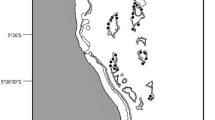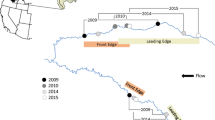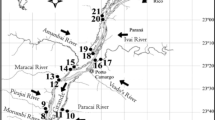Abstract
Many freshwater organisms have a life-history stage that can disperse through seawater. This has obvious benefits for colonization and connectivity of fragmented sub-populations, but requires a physiologically challenging migration across a salinity boundary. We consider the role of landscape boundaries between freshwater and seawater habitats, and evaluate their potential effects on traits and developmental histories of larvae and juveniles (i.e., dispersing life-history stages) of an amphidromous fish, Galaxias maculatus. We sampled juvenile fish on their return to 20 rivers in New Zealand: 10 rivers had abrupt transitions to the sea (i.e., emptying to an open coastline); these were paired with 10 nearby rivers that had gradual transitions to the sea (i.e., emptying into estuarine embayments). We reconstructed individual dispersal histories using otolith microstructure, otolith microchemistry, and stable isotope analysis. We found that fish recruiting to embayment rivers had distinct dispersal and foraging histories, were slower growing, smaller in size, and older than fish recruiting to nearby non-embayment rivers. Our results indicate that landscape edges can affect dispersal capabilities of aquatic organisms, potentially leading to divergent life-history strategies (i.e., limited- versus widespread-dispersal). Patterns also suggest that dispersal potential among landscape boundaries can create heterogeneity in the traits of individuals, with implications for metapopulation dynamics.




Similar content being viewed by others
References
Augspurger JM, Warburton M, Closs GP (2017) Life-history plasticity in amphidromous and catadromous fishes: a continuum of strategies. Rev Fish Biol Fish 27:177–192. https://doi.org/10.1007/s11160-016-9463-9
Berra TM, Crowley L, Ivantsoff W, Fuerst PA (1996) Galaxias maculatus: an explanation of its biogeography. Mar Freshw Res 47:845–849
Boström C, Pittman SJ, Simenstad C, Kneib RT (2011) Seascape ecology of coastal biogenic habitats: advances, gaps, and challenges. Mar Ecol Prog Ser 427:191–217
Bowler DE, Benton TG (2005) Causes and consequences of animal dispersal strategies: relating individual behaviour to spatial dynamics. Biol Rev 80:205–225. https://doi.org/10.1017/S1464793104006645
Bystriansky JS, Schulte PM (2011) Changes in gill H+-ATPase and Na+/K+-ATPase expression and activity during freshwater acclimation of Atlantic salmon (Salmo salar). J Exp Biol 214:2435. https://doi.org/10.1242/jeb.050633
Cadenasso ML, Pickett STA (2008) Effect of edge structure on the flux of species into forest interiors. Conserv Biol 15:91–97. https://doi.org/10.1111/j.1523-1739.2001.99309.x
Cadenasso ML, Pickett STA, Weathers KC, Jones CG (2003) A framework for a theory of ecological boundaries. Bioscience 53:750–758. https://doi.org/10.1641/0006-3568(2003)053%5b0750:AFFATO%5d2.0.CO;2
Campana SE, Thorrold SR (2001) Otoliths, increments, and elements: keys to a comprehensive understanding of fish populations? Can J Fish Aquat Sci 58:30–38. https://doi.org/10.1139/f00-177
Closs Gerard P, Hicks Andy S, Jellyman Phillip G (2013) Life histories of closely related amphidromous and non-migratory fish species: a trade-off between egg size and fecundity. Freshw Biol 58:1162–1177. https://doi.org/10.1111/fwb.12116
Cowen RK, Lwiza KM, Sponaugle S et al (2000) Connectivity of marine populations: open or closed? Science 287:857–859
Crozier LG, Hendry AP, Lawson PW et al (2008) Potential responses to climate change in organisms with complex life histories: evolution and plasticity in Pacific salmon. Evol Appl 1:252–270. https://doi.org/10.1111/j.1752-4571.2008.00033.x
Duelli P, Studer M, Marchand I, Jakob S (1990) Population movements of arthropods between natural and cultivated areas. Biol Conserv 54:193–207
Edelaar P, Jovani R, Gomez-Mestre I (2017) Should I change or should I go? Phenotypic plasticity and matching habitat choice in the adaptation to environmental heterogeneity. Am Nat 190:506–520. https://doi.org/10.1086/693345
Fogarty MJ (1993) Recruitment in randomly varying environments. ICES J Mar Sci 50:247–260. https://doi.org/10.1006/jmsc.1993.1027
Grantham BA, Eckert GL, Shanks AL (2003) Dispersal potential of marine invertebrates in diverse habitats. Ecol Appl 13:S108–S116
Groot C, Margolis L (1991) Pacific salmon life histories. University of British Columbia Press, Vancouver
Gross MR (1987) Evolution of diadromy in fishes. Am Fish Soc Symp 1:14–25
Heath R (1985) A review of the physical oceanography of the seas around New Zealand—1982. N Z J Mar Freshw Res 19:79–124
Hegg JC, Kennedy BP, Chittaro PM, Zabel RW (2013) Spatial structuring of an evolving life-history strategy under altered environmental conditions. Oecologia 172:1017–1029. https://doi.org/10.1007/s00442-012-2564-9
Hickey BM, Banas NS (2003) Oceanography of the US Pacific Northwest Coastal Ocean and estuaries with application to coastal ecology. Estuaries 26:1010–1031. https://doi.org/10.1007/BF02803360
Hickford MJ, Schiel DR (2016) Otolith microchemistry of the amphidromous Galaxias maculatus shows recruitment to coastal rivers from unstructured larval pools. Mar Ecol Prog Ser 548:197–207
Hicks AS, Jarvis MG, David BO et al (2017) Lake and species specific patterns of non-diadromous recruitment in amphidromous fish: the importance of local recruitment and habitat requirements. Mar Freshw Res 68:2315–2323
Hogan JD, Blum MJ, Gilliam JF et al (2014) Consequences of alternative dispersal strategies in a putatively amphidromous fish. Ecology 95:2397–2408
Huey JA, Crook DA, Macdonald JI et al (2014) Is variable connectivity among populations of a continental gobiid fish driven by local adaptation or passive dispersal? Freshw Biol 59:1672–1686. https://doi.org/10.1111/fwb.12373
Jowett IG, Hayes JW, Deans N, Eldon GA (1998) Comparison of fish communities and abundance in unmodified streams of Kahurangi National Park with other areas of New Zealand. N Z J Mar Freshw Res 32:307–322. https://doi.org/10.1080/00288330.1998.9516827
Kaemingk MA, Graeb BD, Willis DW (2014) Temperature, hatch date, and prey availability influence age-0 yellow perch growth and survival. Trans Am Fish Soc 143:845–855
Keefer ML, Peery CA, Caudill CC (2008) Migration timing of Columbia River spring Chinook salmon: effects of temperature, river discharge, and ocean environment. Trans Am Fish Soc 137:1120–1133
Largier JL (1993) Estuarine fronts: how important are they? Estuaries 16:1–11. https://doi.org/10.2307/1352760
Lidicker WZ (1999) Responses of mammals to habitat edges: an overview. Landsc Ecol 14:333–343. https://doi.org/10.1023/A:1008056817939
McClelland JW, Valiela I, Michener RH (2003) Nitrogen-stable isotope signatures in estuarine food webs: a record of increasing urbanization in coastal watersheds. Limnol Oceanogr 42:930–937. https://doi.org/10.4319/lo.1997.42.5.0930
McDowall RM (1984) The New Zealand whitebait book. Raupo
McDowall RM (1997) The evolution of diadromy in fishes (revisited) and its place in phylogenetic analysis. Rev Fish Biol Fish 7:443–462. https://doi.org/10.1023/A:1018404331601
McDowall RM (2007) On amphidromy, a distinct form of diadromy in aquatic organisms. Fish Fish 8:1–13. https://doi.org/10.1111/j.1467-2979.2007.00232.x
McDowall RM (2010) Why be amphidromous: expatrial dispersal and the place of source and sink population dynamics? Rev Fish Biol Fish 20:87–100. https://doi.org/10.1007/s11160-009-9125-2
McDowall RM, Charteris S (2006) The possible adaptive advantages of terrestrial egg deposition in some fluvial diadromous galaxiid fishes (Teleostei: Galaxiidae). Fish Fish 7:153–164. https://doi.org/10.1111/j.1467-2979.2006.00217.x
McDowall RM, Eldon G (1980) The ecology of whitebait migrations: (Galaxiidae: Galaxias spp.). Fisheries Research Division, New Zealand Ministry of Agriculture and Fisheries
McDowall RM, Mitchell C, Brothers E (1994) Age at migration from the sea of juvenile Galaxias in New Zealand (Pisces: Galaxiidae). Bull Mar Sci 54:385–402
Moody KN, Hunter SN, Childress MJ et al (2014) Local adaptation despite high gene flow in the waterfall-climbing Hawaiian goby, Sicyopterus stimpsoni. Mol Ecol 24:545–563. https://doi.org/10.1111/mec.13016
Murcia C (1995) Edge effects in fragmented forests: implications for conservation. Trends Ecol Evol 10:58–62. https://doi.org/10.1016/S0169-5347(00)88977-6
Neilson CSB (2016) There and back again: Spatial and temporal variation in the recruitment dynamics of an amphidromous fish. Master thesis, School of Biological Sciences, Victoria University of Wellington, Wellington, New Zealand
Noonburg EG, Chen A, Shima JS, Swearer SE (2015) Demographic heterogeneity and the dynamics of open populations. Ecology 96:1159–1165
Post DM (2002) Using stable isotopes to estimate trophic position: models, methods, and assumptions. Ecology 83:703–718. https://doi.org/10.1890/0012-9658(2002)083%5b0703:USITET%5d2.0.CO;2
Quinn GP, Keough MJ (2002) Experimental design and data analysis for biologists. Cambridge University Press, Cambridge
Ries L, Fletcher RJ, Battin J, Sisk TD (2004) Ecological responses to habitat edges: mechanisms, models, and variability explained. Annu Rev Ecol Evol Syst 35:491–522. https://doi.org/10.1146/annurev.ecolsys.35.112202.130148
Robinson RA, Crick HQ, Learmonth JA et al (2009) Travelling through a warming world: climate change and migratory species. Endanger Species Res 7:87–99
Shima JS, Swearer SE (2009a) Larval quality is shaped by matrix effects: implications for connectivity in a marine metapopulation. Ecology 90:1255–1267. https://doi.org/10.1890/08-0029.1
Shima JS, Swearer SE (2009b) Spatially variable larval histories may shape recruitment rates of a temperate reef fish. Mar Ecol Prog Ser 394:223–229
Shima JS, Swearer SE (2010) The legacy of dispersal: larval experience shapes persistence later in the life of a reef fish. J Anim Ecol 79:1308–1314
Shima JS, Swearer SE (2016) Evidence and population consequences of shared larval dispersal histories in a marine fish. Ecology 97:25–31. https://doi.org/10.1890/14-2298.1
Shima JS, Noonburg EG, Swearer SE (2015) Consequences of variable larval dispersal pathways and resulting phenotypic mixtures to the dynamics of marine metapopulations. Biol Lett. https://doi.org/10.1098/rsbl.2014.0778
Slade EM, Merckx T, Riutta T et al (2013) Life-history traits and landscape characteristics predict macro-moth responses to forest fragmentation. Ecology 94:1519–1530. https://doi.org/10.1890/12-1366.1
Stevens VM, Pavoine S, Baguette M (2010) Variation within and between closely related species uncovers high intra-specific variability in dispersal. PLoS One 5:e11123. https://doi.org/10.1371/journal.pone.0011123
Stevens JCB, Hickford MJH, Schiel DR (2016) Evidence of iteroparity in the widely distributed diadromous fish inanga Galaxias maculatus and potential implications for reproductive output. J Fish Biol 89:1931–1946. https://doi.org/10.1111/jfb.13083
Swearer SE, Shima JS, Hellberg ME et al (2002) Evidence of self-recruitment in demersal marine populations. Bull Mar Sci 70:251–271
Waters JM, Dijkstra LH, Wallis GP (2001) Biogeography of a southern hemisphere freshwater fish: how important is marine dispersal? Mol Ecol 9:1815–1821. https://doi.org/10.1046/j.1365-294x.2000.01082.x
Woodroffe R, Ginsberg JR (1998) Edge effects and the extinction of populations inside protected areas. Science 280:2126. https://doi.org/10.1126/science.280.5372.2126
Acknowledgements
We acknowledge funding from the National Science Foundation (DBI 1306226) and Victoria University of Wellington; logistic support from Victoria University Coastal Ecology Laboratory; and research assistance from J. Bottcher, C. McDowall, C. Neilson, V. Wood, T. Bates, B. Focht, D. McNaughton, B. Moginie, D. Crossett, B. Focht, A. Kaemingk, A. Kilimnik and J. Brown. We thank C. Chizinski for statistical advice and three anonymous reviewers for improving this manuscript.
Author information
Authors and Affiliations
Contributions
MK and JS jointly obtained funding, designed the study, supervised technicians, and drafted the paper with input from the other coauthors. MK analyzed the data. SS conducted LA-ICP-MS analysis. MK and SB conducted stable isotope analysis.
Corresponding author
Additional information
Communicated by Joel Trexler.
Electronic supplementary material
Below is the link to the electronic supplementary material.
Rights and permissions
About this article
Cite this article
Kaemingk, M.A., Swearer, S.E., Bury, S.J. et al. Landscape edges shape dispersal and population structure of a migratory fish. Oecologia 190, 579–588 (2019). https://doi.org/10.1007/s00442-019-04440-x
Received:
Accepted:
Published:
Issue Date:
DOI: https://doi.org/10.1007/s00442-019-04440-x




